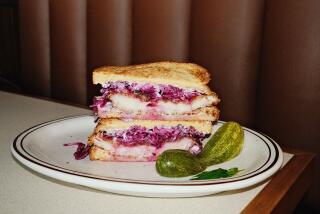Jelly Belly creator sour over lost legacy but sees sweet future
- Share via
His hair is disheveled; his red polo shirt stained. He’s prone to shuffling when he walks and wears an oversized cowboy hat embroidered with jelly beans.
“Now who here likes candy?” he asks, his voice both raspy and childish.
The group of preschoolers who arrived with their mothers stare at the peculiar stranger and realize he is speaking their language.
David Klein leads the way through his small Covina factory, where giant bags of dextrose and malic acid line the hall.
PHOTOS: The man behind Jelly Belly jelly beans
As he points out the barrels of powdery sugar “sand,” he tosses chewy sour balls, licorice wands dipped in sugar nuggets and candy shaped like sushi into the children’s plastic sacks.
It’s the tame end of Klein’s inventory — around him are specimen cups brimming with lemon-flavored candy urine, anatomically correct gummy hearts that gush cherry-flavored “blood” and fruity sugar pebbles called “Farts” — fare that he sells wholesale.
Midway through the tour, Klein stops and his tone shifts. He can’t resist.
“Does anybody know what candy I created a long time ago?”
They wait.
“Jelly. Belly. Jelly beans.”
An awed oooh is the response from the mothers who know well the confection that had America falling in love.
And then come the confused looks.
The man who inspired the Jelly Belly empire is now in this no-frills candy factory, giving midday $5 tours to stay-at-home moms and their tots?
The way Klein tells it, it’s a frustrating tale of a legacy lost.
Now, years out of the limelight, he’s convinced a comeback is right around the corner, arriving in the shape of that old friend: the jelly bean.
But this will be no ordinary bean. So spectacular and scrumptious, he believes, it’s bound to turn a foray gone bitter into something marvelously sweet.
::
They once were unremarkable globs of pectin coated in sugar, known for their ability to last for months in candy dishes.
In the spring, they surfaced to line the bottoms of Easter baskets. The rest of the time, they lived a life as simple penny candy.
Then, in 1976, Klein was living in Temple City and working as a distributor for Garvey Nut when he dreamed up a mini version with shells and insides that would burst with flavors like cream soda and watermelon — exotic at the time. It would be marketed as a gourmet treat and sell for $2 a pound, a costly sum for a jelly bean.
To bring his vision to life, Klein, 30, ordered a batch from the Herman Goelitz Candy Co., a Bay Area manufacturer whose products he sold. Goelitz developed recipes for his desired flavors, made the beans and shipped them to him. He dubbed the candy Jelly Belly — inspired by folk and blues musician Lead Belly.
Klein rented a corner of Fosselman’s Ice Cream store in Alhambra to hawk his beans and commissioned the niece of one of its owners to design the logo: a bright-red bean with yellow highlights and its name across the middle.
The ice cream shop had a flow of steady customers, but Jelly Belly was considered ludicrously priced. Klein had 300 pounds of candy and no takers.
“As soon as you walked in the door it was to your right and that man would pounce on you,” recalled Alhambra resident Rose Marie Turney-Markus, a frequent customer at the time. “He was so energetic and wanted you to try this and that.”
Klein was a showman. After persuading an Associated Press writer and photographer to visit the ice cream shop, he arranged for family and friends to form a line snaking out the door.
Within days, customers began calling Fosselman’s. Candy boutiques clamored for bulk orders, the gourmet jelly beans were tucked into gift baskets and sought out for Mother’s Day presents. Aficionados mixed flavors to create jelly bean cocktails
Klein was suddenly on talk shows and posing shirtless in a tub filled with jelly beans for People magazine. Inside his home was a dedicated “bean room” with boxes of orders to be shipped.
And then Jelly Belly got its biggest boost. A devotee became president of the United States.
For years, Ronald Reagan had eaten ordinary jelly beans after initially turning to them to curb his pipe smoking habit. While governor of California, he received shipments from Goelitz. Then Goelitz began producing Jelly Belly and Reagan became a fan.
Goelitz shipped 7,000 pounds of red, white and blue beans to the White House for Reagan’s inauguration in 1981.
For Klein, it should have been a brilliant moment. Except by then he had given up all rights to the candy.
::
Even Klein has trouble comprehending why — why someone who studied economics at UCLA, earned a law degree and was obsessed with candy agreed to relinquish his own flourishing product.
But Klein was an idea man, not a candy maker, and left it to Goelitz to cook up the Jelly Belly recipes. He relished marketing and playing the role of Mr. Jelly Belly, the company face at events and promotions, but it left him little time to step back and understand where the company was headed. He also had kept his job as a distributor.
In the fall of 1980, several Goelitz executives flew down with a proposition. They would give him and a partner he had taken on $10,000 apiece every month for 20 years in exchange for the trademark to Jelly Belly.
Klein refused. But then he said he got the sense that the company would continue making the beans without him. Klein did not have the formula and was not versed in manufacturing. Taking his business elsewhere seemed daunting and futile. His partner was ready to retire, and urged him to sign the agreement.
Klein said he caved. And regretted it an instant later.
Herman Rowland Sr., head of Goelitz, said Klein appeared happy with the deal. Goelitz had struggled before Jelly Belly and poured everything it had into the product. Rowland found Klein to be likeable but unreliable when it came to business and he worried about the company’s future.
“It was really a time of turmoil and we were on a shoestring — we had nothing to stand on,” Rowland said.
The company wanted to offer Klein a generous deal before being forced to create a competing jelly bean, Rowland said.
The company, Rowland said, credits Klein with the name and the idea of using natural flavors and purees but believes he has greatly exaggerated his involvement.
Goelitz eventually changed its name to Jelly Belly Candy Co. Its annual net profit is estimated by Candy Industry magazine to be about $193 million.
There was no mention of Klein in the company’s 30-year anniversary fact book. And its website makes only a vague reference to an early relationship with an unnamed candy distributor.
Mr. Jelly Belly is now a cartoon character shaped like a jelly bean.
::
Jelly Belly, Klein came to believe, ruined his life.
He had been an off-beat, fanciful father who would take his children to amusement parks and buy up a bundle of balloons just to hand out to other kids. Sometimes he would rent an ice cream truck to distribute free treats. But when the jelly beans slipped through his fingers, Klein sank into depression.
“I remember so much happiness in the house, when my dad was on TV,” recalled Bert Klein, who said his relationship with his dad changed when he was a grade-schooler. “When he lost Jelly Belly, it was like parting with a child. I knew very little, but I knew it made him an unhappy person, which drove me away.”
Klein’s buoyancy and verve were gone, replaced by bitterness and insecurity. He said he couldn’t shake the feeling that he had been coerced into giving up but believes he might have gotten over it had the company lauded him at Jelly Belly events.
The buyout money was nice, he said, although it never made Klein and his wife rich. After a while he simply stopped telling people about his past.
::
Klein is 64 now, living in Glendora with his wife, Rebecca.
Once a week he goes to his modest factory that is overseen by his daughter Roxanne.
Most of the time he brainstorms ideas for candy at his red-brick home, surrounded by packages of freeze-dried pineapple powder, empty soda bottles, boxes of gummy confections and his grandchildren’s toys.
He cuts an odd figure, scuffling around outdoors in black socks, using his shirt as a napkin, writing notes to himself on a stack of paper plates, running fingers through unkempt hair.
Last year, Bert, an animator for Disney, released a documentary about his father’s connection to Jelly Belly. When Bert had children of his own, he said he wanted to understand exactly what his father had lost.
“Candyman: The David Klein Story” portrays an eccentric, obsessive nobody crushed by a corporation.
The film and the fans who saw it and have since tracked him down have invigorated Klein. One executive even came to him and said he would bankroll his next candy.
Sure, he thinks it would be grand to come up with a bestselling chocolate bar or a triumphant taffy, but Klein can’t shake the need to prove he’s still a genius when it comes to jelly.
This time he’s aiming for a spot with the chocolatiers and high-end candy boutiques, not the aisles of Wal-Mart and Costco that Jelly Belly now populates.
The candy will be called David’s Signature Beyond Gourmet Jelly Beans and come in exotic flavors like Thai curry and bacon-wrapped dates. It will be manufactured by Marich Confectionery, whose founder Marinus van Dam once worked at Goelitz and developed the jelly bean recipes for Klein.
Financed by Leaf Brands, whose chief executive reached out to Klein after seeing the documentary, the packages will read “from the inventors of the Jelly Belly.”
Last month at the Sweets and Snacks Expo in Chicago, Klein donned his jelly bean hat and grinned while posing for photos. It was the first candy show he had been to in years, and the documentary had given him something he has craved for decades: recognition.
PHOTOS: The man behind Jelly Belly jelly beans
More to Read
Sign up for Essential California
The most important California stories and recommendations in your inbox every morning.
You may occasionally receive promotional content from the Los Angeles Times.














